High Peaks Pure Earth has translated a blogpost by Woeser that was originally written for broadcast on Radio Free Asia on September 14, 2010 in Beijing and posted on her blog on September 21, 2010.
The blogpost reflects on a major contemporary Tibetan art exhibition that is being held in Beijing at the moment. As Woeser writes, the first Tibetan contemporary art exhibtion took place in Beijing in 2007 and was titled in Chinese 发生发声 (fasheng fasheng). This is how the curator of the 2007 show, Leigh M. Sangster, explains the Chinese characters:
The first [fasheng] means “Happening“ and is a reminder that much is going on here in Lhasa’s art world. The second [fasheng] means “to make a sound“, and suggests artists in Lhasa are finding and using their own indigenous voices.
The English title of the 2007 exhibition in Beijing was the rather staid “Lhasa – New Art from Tibet”. For the purposes of the translation below and to keep the themes of voices and expression that are found in the article, we have stuck with the literal translation of the 2007 exhibition, “Happening, Voices”.
Woeser’s blog has featured much of the art work on display in Beijing. Please see the following links to Woeser’s blog to see the work by various Tibetan artists:
Gade: http://woeser.middle-way.net/2010/09/blog-post_13.html
Tsering Nyandak: http://woeser.middle-way.net/2010/09/blog-post_14.html
Phurbu and Jampel: http://woeser.middle-way.net/2010/09/blog-post_15.html
Yak Tseten and Tsege: http://woeser.middle-way.net/2010/09/blog-post_16.html
Shelkawa A Nu and Penpa: http://woeser.middle-way.net/2010/09/blog-post_17.html
Pema Rigzen, Phurbu Gyalpo, Karma Dorjie Tsering, Gonkar Gyatso, Tenzing Rigdol, Kesang Lamdark, Tsering Sherpa and Palden Weinreb: http://woeser.middle-way.net/2010/09/blog-post_18.html
Kaka21, Tashi Norbu, Penba Wangdu, Penpa, Jhamsang, Kaltse, Tashi Phuntsok, Ang Sang, Tsering Dolma, Tenzin Dhargya and Suomani: http://woeser.middle-way.net/2010/09/blog-post_19.html
“Those Giving Voice to ‘Scorching Sun of Tibet'”
By Woeser
Three years ago, for the first time, an exhibition on contemporary Tibetan art was held in the 798 Art District in Beijing. Under the title of “Happening, Voices”, seven Tibetan artists expressed their aspiration to record and portray the current situation in Tibet as well as to create a voice for today’s Tibetan people through art. Three years later, during the Songzhuang Art Festival, another exhibition on contemporary Tibetan art opened in Beijing. Fifty artists participated, of whom about 80% are Tibetan, including Tibetan artists from Amdo and Kham as well as some who live in the West. The remaining artists are all Han Chinese who have been or are still living in Lhasa. This is the first time that contemporary Tibetan art has been exhibited on such a large scale. More importantly, this exhibition is not expressing the views of the government but those of ordinary citizens.
Through the title “Scorching Sun of Tibet”, it can be observed that the content expressed in the exhibition has moved from the surface to the centre; it is stimulating and greatly diverse; and it also conveys a certain kind of feeling that cannot be neglected within this “to be spoken” yet “unspoken” situation. As Mr. Li Xianting, curator of this exhibition, put it: it is a feeling of “bitter anguish!” This reminds me of a film about the Soviet Union from a few years ago, it is called “Burnt by the Sun”. I have watched it over and over again. The Soviet Union was not the only country that exerted “burning pain” on its people. Any totalitarian system exerts on its people the same kind of pain. That is also why we all feel the same way.
As an independent curator and well known sharp-eyed art critic, Mr. Li noticed that “fundamental boundaries” exist between the artistic expressions of native and non-native Tibetan artists. The reason for the existence of such boundaries is that “none of us non-natives can really experience but can only sense the cultural identity crisis, the contradictions of beliefs, the tainted religion, the damaged and broken culture, the polluted environment, the gravity of Han assimilation, the invasion of Western consumerism and so on that have caused this bitter anguish amongst Tibetans!” Another curator of the exhibition, Tibetan artist, Gade, pointed out that in today’s world “every Tibetan is experiencing a change of soul and belief, something that can only be truly experienced and expressed by ourselves”.
Another one of Gade’s remarks is also important: “how many out of thousands of artistic works dealing with Tibet are actually expressed in our mother tongue? Even though there are some, they have already been altered to appear in a kind of ‘self-other’ expression.” It is true that due to its particular environment and situation, Tibet has long been depicted by different competing powers and has been silent itself, not because it cannot speak but because it has been “sheltered” consciously or unconsciously by valiant powers. Tibet always seems to be there but actually never is. Hence, Tibetans themselves should articulate the “real discourse” of Tibet. Yet the problem is which standpoint we should uphold. A Tibetan expression is certainly a reliable source in depicting Tibet but without an independent and critical spirit their expressions of Tibet are but parrot repetitions.
The Tibet under the “scorching sun” is the real Tibet. One’s skin might burn or one’s heart might even be injured in this “scorching sun” but artistic expressions can be an effective medicine to cure the pain. We see native Tibetan artists telling many stories from under the “scorching sun”: some of them in tears, some of them humorous and some of them shocking. For instance, Nortse portrays thirty Tibetan letters imprisoned in an iron coffin; Yak Tseten and Tsege built a tower of alcohol shaped like a Stupa out of more than two thousand empty beer bottles; instead of Buddhist scriptures, Gade carved the political doctrines that fill our daily lives on a prayer wheel, thus directly accusing the souls of every Tibetan who has been involved in and is responsible for this. However, the work that impressed me the most was a series of oil paintings by Nyendak, portraying a child with a grave and innocent look on its face, whose gender is indistinguishable and who seems helpless but shows no weakness.
Beijing, September 14 2010

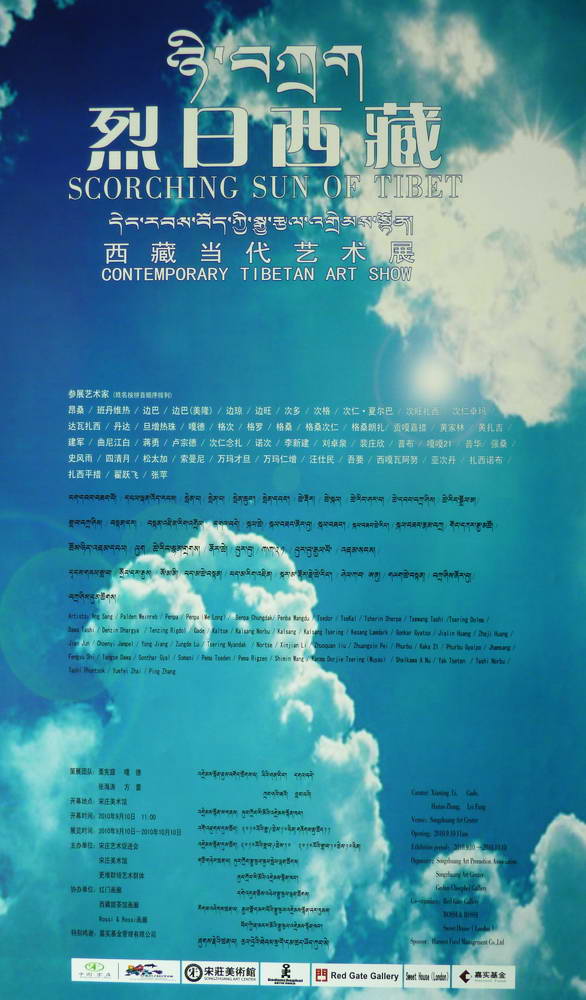

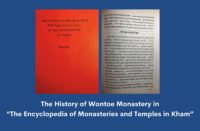
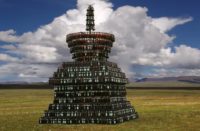
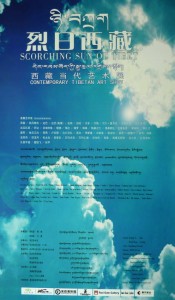
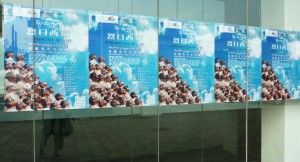
Thank you for vivid translation of Woeser's insightful reflections on this ground-breaking exhibition and its implications in Beijing, in Tibet, reaching far beyond those political and cultural borders.
What a powerful and important statement. Thank you for translating and reprinting it. How wonderful to know of Woeser's writing and that such exhibits exist.
Thank you very much for being transcribed so vividly. I do appreciate the exhibition and I am happy to read your translations.
We Tibetan must step forward in every second, we will obtain our aspiration.
Thanks you all.
We're happy that this translation seems to have resonated with many readers. Thank you all for your comments!
Thank you for the translation. it can circulate this way around the world. do you know if there is a catalogue printed of the exhibition?
Pingback: “Tibet” is a Mark Deeply Impressed on Our Foreheads and in Our Hearts By Woeser